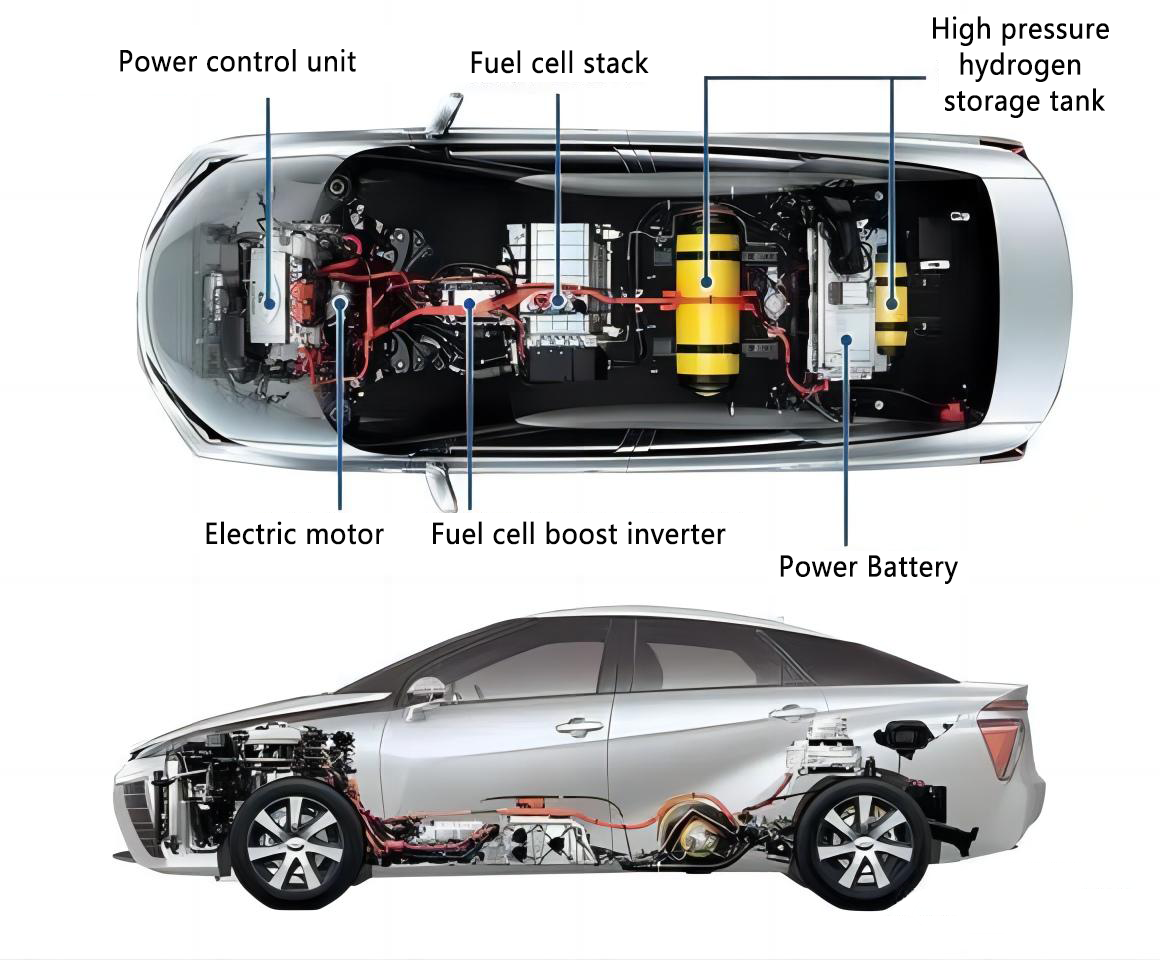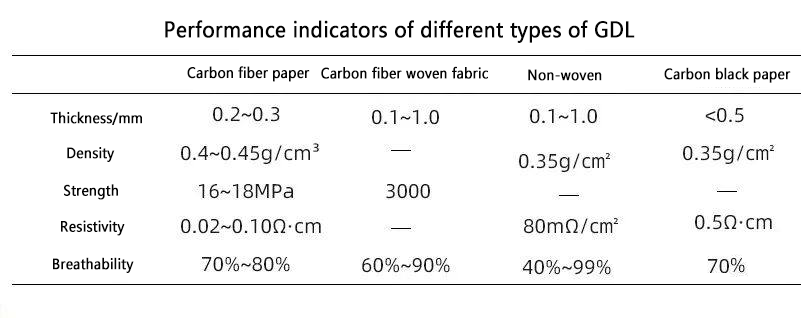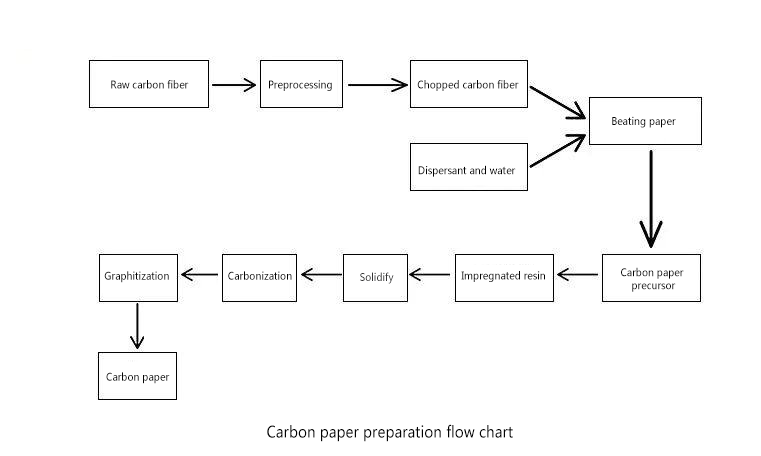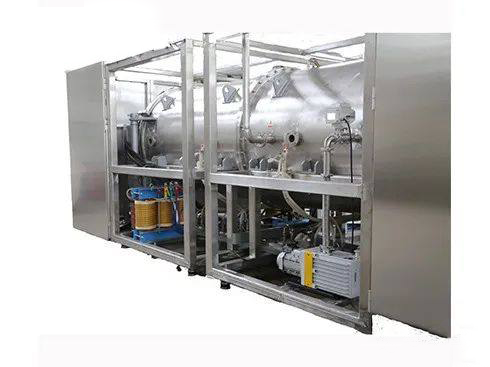- English
- Español
- Português
- русский
- Français
- 日本語
- Deutsch
- tiếng Việt
- Italiano
- Nederlands
- ภาษาไทย
- Polski
- 한국어
- Svenska
- magyar
- Malay
- বাংলা ভাষার
- Dansk
- Suomi
- हिन्दी
- Pilipino
- Türkçe
- Gaeilge
- العربية
- Indonesia
- Norsk
- تمل
- český
- ελληνικά
- український
- Javanese
- فارسی
- தமிழ்
- తెలుగు
- नेपाली
- Burmese
- български
- ລາວ
- Latine
- Қазақша
- Euskal
- Azərbaycan
- Slovenský jazyk
- Македонски
- Lietuvos
- Eesti Keel
- Română
- Slovenski
- मराठी
- Srpski језик
Types and preparation methods of gas diffusion layers for hydrogen fuel cells
2024-04-08
A fuel cell is a chemical device that directly converts the chemical energy of fuel into electrical energy, also known as an electrochemical generator. It is the fourth power generation technology after hydropower, thermal power and atomic power.
Because the fuel cell converts the Gibbs free energy part of the chemical energy of the fuel into electrical energy through electrochemical reactions, it is not limited by the Carnot cycle effect, so it is highly efficient; in addition, the fuel cell uses fuel and oxygen as raw materials; at the same time There are no mechanical transmission parts, so there is no noise pollution and very few harmful gases are emitted.
It can be seen that from the perspective of energy conservation and ecological environment protection, fuel cells are a promising power generation technology.


1: Fuel cell GDL functions and requirements
1: Fuel cell GDL function
GDL is one of the important components of fuel cells. Its main functions are:
▪ Catalyst carrier
▪ Support motor structure
▪ conductivity
▪ The role of uniform diffusion of gas
▪ Diffusion layer water transport
2: Fuel cell GDL requirements
▪ Uniform porous structure, good breathability
▪ Low resistivity and strong electron conductivity
▪ The structure is compact and the surface is flat, which reduces contact resistance and improves conductive performance.
▪ It has certain mechanical strength, appropriate rigidity and flexibility, which is conducive to the production of electrodes and provides stability of the electrode structure under long-term operating conditions.
▪ Appropriate hydrophilic/hydrophobic balance to prevent excessive moisture from blocking pores and causing a decrease in gas permeability
▪ Has good chemical stability and thermal stability.
3: Fuel cell GDL features
Based on the above requirements for gas diffusion layers, after years of research and development, the gas diffusion layer materials that are currently maturely used in fuel cells are carbon materials.
▪ Advantages of carbon materials: It has both high conductivity and strong resistance to electrical corrosion, and has low cost, which is an advantage that other materials do not have.
▪ Disadvantages of carbon materials: Carbon materials are brittle in nature, which is not conducive to molding and processing, and it is also difficult to control their microstructure.
Therefore, studying the use of carbon materials to prepare gas diffusion layers with excellent performance has become the focus of research.

Types and preparation methods of GDL materials - carbon paper

Carbon paper is light in weight, has a flat surface, is corrosion-resistant, has uniform pores and has high strength. Its thickness can be adjusted according to usage requirements, making it suitable for durable fuel cells.
When preparing carbon paper, in addition to the steps of preparing raw materials, pulping, impregnation, and curing, carbonization and graphitization are also required.

Types and preparation methods of GDL materials - carbon fiber woven cloth
Carbon fiber woven cloth solves the brittleness problem of carbon paper. However, carbon fiber woven cloth easily expands and contracts in the plane direction, resulting in large deformation, which brings difficulties to the preparation of electrodes.
The surface flatness of carbon fiber braid is poor and the catalyst is unevenly attached, which affects the stability of the fuel cell.
Types and preparation methods of GDL materials - non-woven fabrics
The characteristics of non-woven fabrics are that they have no warp and weft threads, and are light in weight, which is conducive to shaping, making up for the brittleness of carbon fiber paper and the easy deformation of carbon fiber woven fabrics. The porosity can be controlled from the raw material stage as needed.
However, its process is also complex, its strength and durability are poor, and it is easy to crack at right angles, making it difficult to meet the durability requirements of fuel cells.
Types and preparation methods of GDL materials - carbon black paper
Carbon black paper is a flat diffusion layer material made by hot pressing molding process after evenly dispersing carbon powder and binder. Carbon powder is generally activated carbon, carbon black, acetylene black, graphite powder, or a mixture thereof. The binder is polyvinylidene fluoride or polytetrafluoroethylene, etc.
Since carbon black paper is a brittle material, it is difficult to become an ideal GDL material.

Three: Characterization and testing of GDL properties
In GDL, the transfer of reaction gases, the transfer of reaction products and the transmission of electrons are mainly carried out. Therefore, examining the properties of GDL mainly examines the delivery capabilities of these three aspects. At present, some physical means have been established to characterize the properties of GDL, mainly including the fluid transport characteristics, conductivity, pore structure, and hydrophilic and hydrophobic characteristics of GDL.
1: Fluid transmission characteristics
The fluids in GDL are mainly reaction gases, water vapor and liquid water. The main mode of gas transfer in the diffusion layer is diffusion, which also includes partial convective mass transfer. The liquid permeability can be used to characterize the flow resistance of the liquid. Place a certain liquid on the porous GDL surface and apply a certain pressure to make the liquid flow through the GDL. The relationship between the flow rate and the pressure drop can be used to characterize the flow resistance of the liquid in the GDL. Delivery ability.
2: Pore structure
Porosity, pore distribution and pore volume are important parameters of the pore structure of the diffusion layer. Commonly used pore structure measuring instruments include mercury porosimeter and capillary flow porosimeter.
The former uses mercury as the wetting fluid and applies a certain pressure to press the mercury into the pores of the sample to be tested. The latter uses silicone resin with low surface energy as the medium, which wets the sample to be tested under the action of capillary force and then presses it to flow out of the pores.
However, neither method can reflect the real material transmission channel in the diffusion layer when the battery is running, because the non-connected pores in the gas diffusion layer material are meaningless for material transmission, and when measured by mercury intrusion method or capillary flow porosimeter, Broken holes and dead holes are included.
3: Hydrophilic/hydrophobic properties
The liquid wettability of GDL, that is, its hydrophilic and hydrophobic properties, is also one of the important factors affecting fuel cell performance. An appropriate ratio of hydrophilic/hydrophobic pores is beneficial to improving mass transfer and increasing the ultimate current density. There are two methods to characterize the hydrophilic/hydrophobic properties of GDL:
The first is the dipping method, which directly characterizes the pore volume of its hydrophilic pores and hydrophobic pores; the second is the contact angle measurement method, which indirectly characterizes the hydrophilic/hydrophobic properties.
The impregnation method uses the total pore volume minus the hydrophilic pore volume to obtain the hydrophobic pore volume. This method has low measurement accuracy and large experimental errors. The size of the contact angle only reflects the surface properties of the gas diffusion layer. Since the surface of the diffusion layer is relatively hydrophobic, but the distribution of the hydrophobic agent inside is not necessarily uniform, the affinity of the diffusion layer can be judged by measuring the contact angle. Water properties are inaccurate.
4: Conductivity
The conductivity of the diffusion layer generally has two measurement methods depending on the measurement direction.
For the through-plane direction, that is, the thickness direction of the GDL, the method of measuring contact resistance under pressure is generally used, while for the resistance in the in-plane direction, the four-point probe method is often used.
Generally, the resistance in the through-plane direction is one order of magnitude greater than the resistance in the in-plane direction. This is due to the anisotropy of the carbon paper caused by the arrangement direction of the fibers during the carbon paper preparation process.





